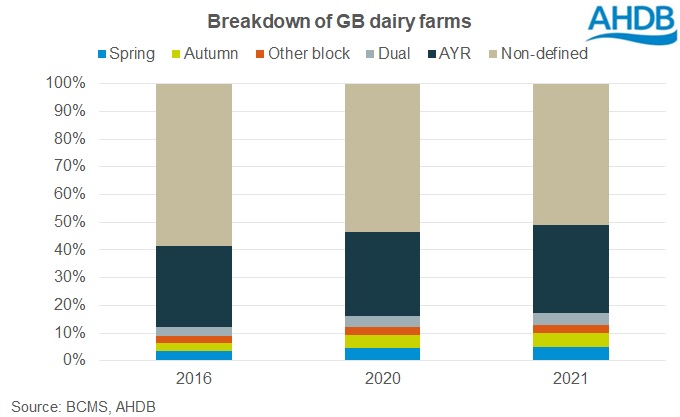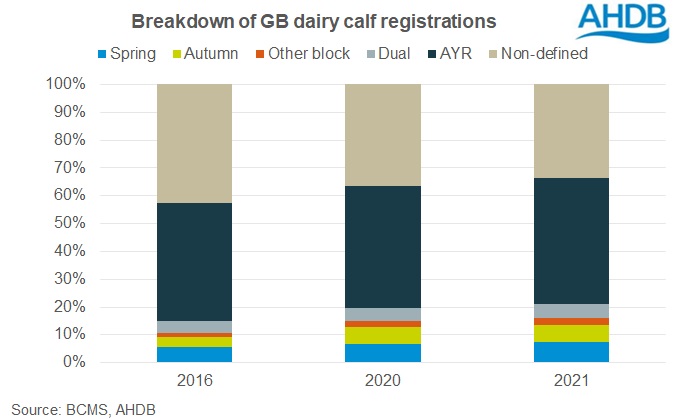GB dairy farmers embrace block calving systems
Wednesday, 20 April 2022
Since the launch of AHDB’s Optimal Dairy Systems programme in 2017, the share of GB dairy farmers who operate defined calving systems has steadily increased. In 2016, just over 12% of GB dairy farms operated a block calving system, with spring and dual blocks being the most prevalent. All year round (AYR) systems accounted for about 30% with the remaining farms (58%) operating somewhere between the two.
According to 2021 BCMS calf registration data, the share of GB farms operating block calving systems has increased to 17.1%, and AYR systems have increased to 32.0%. The largest increase has been in the share of farms operating an autumn block system, moving up from 2.8% of farms in 2016 to 5.0% in 2021. The increased focus on actively operating a defined calving system has meant the share of farms falling between the defined systems has dropped from 58.5% to 50.9%.

When we look at the number of calf registrations allocated to each system, farms referred to as “non-defined” above had the smallest number of calf registrations in the year, averaging 122 in 2021 (compared to 120 in 2020). In comparison, the AYR group averaged 259 registrations per farm, a 3.4% increase from the average of 250 the previous year.

As a result, we would estimate around 21.0% of calf registrations are from block calving herds – double the number in 2016. AYR herds accounted for 45.3% of calf registrations in 2021, up from 43.8% in 2020 and 42.4% in 2016. In line with the increased focus on operating a defined system, the number of registrations to farms in the ‘non-defined’ category has fallen considerably since 2016, accounting for 33.8% in 2021.
The Optimal Dairy Systems approach is aimed at helping farmers reduced costs and increase efficiency in a way that is most appropriate for them. Our KPI Express Calculator allows farmers to check and compare how their performance measures up against likeminded farmers. This allows them to highlight areas for improvement, while our network of Strategic Dairy Farms provide the ability to share good practice through on-farm visits.
Notes and definitions
Historically, the breakdown of system in GB has been based on farmers’ self-assessment of which system they believe they operate. 2020 was the first time we were able to see the breakdown based on calf registrations for each farm in the country.
The data excludes any farms where all registrations were for non-dairy calves, and also excludes farms who had less than 25 calf registrations in the year.
Our farm key performance indicators suggest block calving herds should target 85% of calvings within a 6-week window, although the “good” level is set at between 70-85%. For this analysis we have used a wider definition of 4 months and 80% of registrations as set out below:
- Spring block: 80% of registrations occur within 4 months from 1 Feb to 31 May
- Autumn block: 80% of registrations occur within 4 months from 1 Aug to 30 Nov or 1 Sep to 31 Dec
- Other block: 80% of registrations occur within 4 months other than defined in spring or autumn block
- Dual block: 90% of registrations occur within the spring block or autumn block windows defined above.
- AYR: Registrations are spread relatively evenly throughout the year, but that can be based on a 12-month, 11-month or 10-month calving system. 12-month means each month sees 3.3%-13.3% of annual registrations. 11-month means 4.1%-14.1% of annual registrations in 11 months of the year, and 10-month means 5%-15% of annual registrations in 10 months of the year.
- Non-defined: covers any farm not falling into one of the other categories.

Sign up to receive the latest information from AHDB.
While AHDB seeks to ensure that the information contained on this webpage is accurate at the time of publication, no warranty is given in respect of the information and data provided. You are responsible for how you use the information. To the maximum extent permitted by law, AHDB accepts no liability for loss, damage or injury howsoever caused or suffered (including that caused by negligence) directly or indirectly in relation to the information or data provided in this publication.
All intellectual property rights in the information and data on this webpage belong to or are licensed by AHDB. You are authorised to use such information for your internal business purposes only and you must not provide this information to any other third parties, including further publication of the information, or for commercial gain in any way whatsoever without the prior written permission of AHDB for each third party disclosure, publication or commercial arrangement. For more information, please see our Terms of Use and Privacy Notice or contact the Director of Corporate Affairs at info@ahdb.org.uk © Agriculture and Horticulture Development Board. All rights reserved.

